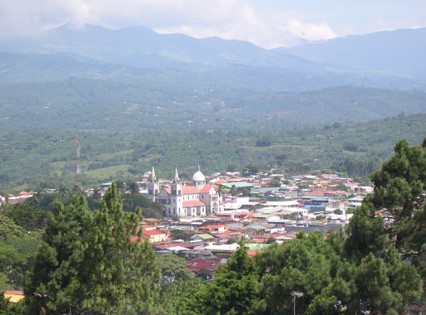A colorful parade of saints lined up along the aisle of the church in San Ramón during the last weekend of August as the city celebrated its patron saint’s day with an old Spanish custom: la entrada de los santos, or the parade of the saints.
This year, 53 venerable statues of saints came from surrounding parishes and organizations in this western Central Valley coffee canton. The statues, some old and valuable, were borne on platforms decorated with flowers, carried on the shoulders of men and women from the parishes or groups. Each saint was accompanied by a band playing music, some traditional, some religious.
This was a festival, nothing grim about it. There was St. John the Baptist carrying his long staff, the Virgin of El Carmen, the Virgin of Ujarrás and the Virgin of the Angels, a replica of the national shrine in the basilica in Cartago, east of the capital. St. Barbara, the patron saint of firefighters, was accompanied by a fire truck. The Holy Family came along with saints Gabriel and Raphael, the archangels. The images will remain in the church for nine days, or a novena, with daily Masses dedicated to the different parishes, explained Daniel Vargas, San Ramón’s young and energetic pastor.
The principal saint of this event, of course, is San Ramón Nonato, and his statue, dressed in the red cloaks of a church official, had a special platform in front of the altar decorated with streamers in red and white.
San Ramón is the patron saint of pregnant women and newborn babies, Vargas said. He was born in the 1200s in Spain.
His mother died giving birth to him, and he was delivered and adopted by a man named Ramón Cardona, who gave him the name Nonato, or “no birth.” At the age of 19, young Ramón joined the Fathers of Mercy, an order of priests dedicated to buying slaves to save them, and he went to Algeria, where slavery flourished. When funds ran out to buy more slaves, Ramón offered himself in place of a slave until more funds were available.
Pope Gregory IX wanted to honor the young priest by making him a cardinal, but with his health compromised during the episode of slavery, Ramón died on the way to Rome, at the age of 36.
The annual celebrations attract visitors from all over Costa Rica, because los ramonenses provide a week full of civic, religious and cultural activities. This year’s included a zoo full of farm animals so that young city dwellers could get to know them. There were oxcart parades, folk dances, a sculpture contest, a band parade, theater and the reopening of the regional museum, displays of organic products and plants, and lots of traditional food under a thatch-roofed pavilion that spanned the entire street. A city that works together can produce a first class party.
“This is a family event to bring people together,” Vargas said. “With thousands of people filling the streets of San Ramón, no car thefts, assaults or vandalism were reported. And no alcohol was sold.”
San Ramón was first settled by the Maleku indigenous group. During the colonial years, the area was considered to be “the interior,” and prisoners and undesirables were sent here as punishment. In the early 1800s, expansion from Palmares, another western town, brought settlers into the area.
Early residents Ramón Solís and Ramón Rodríguez placed the new town under the protection of San Ramón, and in August 1854 it officially became a city.
San Ramón became known as a literary and cultural center in the 19th century, after a priest of that era published an epic poem that scandalized citizens for not giving full support to the church, and which was read across the nation. This literary effort drew other poets and writers to San Ramón, giving it a reputation for arts and letters.
Leading statesman and founder of modern Costa Rica, José “Pepe” Figueres, was born in San Ramón in 1906. His home across from the church is now a cultural center. A branch of the University of Costa Rica is located here, and its professors and students add to the cultural life of the city.
And every year, during the last week of August, the whole community comes together to celebrate their patron saint’s day, Aug. 31.






